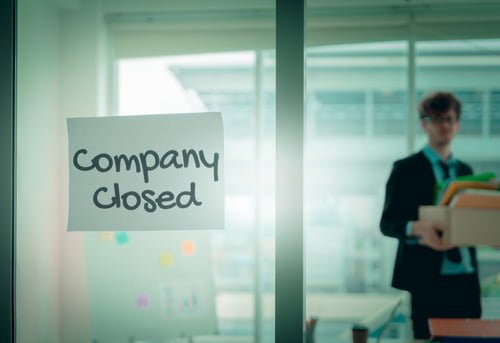“Our company has no future; we are worried that will be personally liable for debts. What is the quickest cheapest solution” assets are collected.
What Is Creditors Voluntary Liquidation (CVL)?
There is a solution. It is called liquidation or more specifically creditors voluntary liquidation. KSA Group can help you to end the worry and get the liquidation of a limited company completed quickly and professionally. We can help you stop those creditor calls and worries, end those sleepless nights and ultimately help you, as directors, get on with your life.
Why not download our 50 page complete experts guide to liquidation
We could help you start the liquidation process today, please call on 08009700539 in office hours 8.30am till 5.00pm. Or call Wayne Harrison (IP) direct on 07879 555349 or Eric Walls (IP) direct on 0778 727 8527 or email help@ksagroup.co.uk. If your enquiry is out of hours you can call our mobile on 07833 240747
FIRST the simple description of a creditors voluntary liquidation (CVL)
Every day people ask us what is a voluntary liquidation. Creditors voluntary liquidation or compulsory liquidation means the end of the company’s life and its assets are then “liquidated” or turned into cash for the creditors if possible. Creditors voluntary liquidation is the most common form of liquidation in use in the UK. In fact, in the 4th quarter of 2023, the total number of companies that went into liquidation was 2,484. Around 15,000 companies will be closed this way per year.
Usually the company has run out of cash, the directors do not think it is viable, they know the company cannot pay its debts on time and the directors are concerned that the business may build up more debts. They are also worried about Wrongful Trading.
A CVL can bring a quick end to the worry, if you act soon enough and have acted properly as directors. Yes, you can be a director of another company after a liquidation, but it is important to note that there are strict controls over the re use of a company name. This is covered by section 216 of the Insolvency Act. It is in fact a criminal offence to use a same or similar sounding name.
So for example Fox and Hound Building Company Limited goes into liquidation and then you start another company called Hound and Fox Buildings Limited. This can be a criminal offence and if the second company fails you would have NO PROTECTION and be held liable for the debts of that second failed company. Get specialist help from us on this on 08009700539.
What is a “phoenix company”?
You can liquidate a limited company and start the same business again, but only under strict rules and conditions as above. This is a potential legal “minefield” and you need to take proper advice. Call us or read the detailed CVL guides if you want more details.
What if the company can be viable?
But, before you decide on liquidation as the appropriate option, you should also consider whether your company can be viable if radically restructured and, if so, how can you get help. If there is a viable business in there but you are tired and distressed, we can still help.
We can show you how to reduce costs, settle debts and restructure the company. We have 25 years’ experience in this work and many people call us saying liquidate my company please! Then once we take away the pressure and look harder at the business problems, we can often see a solution. This could be trading out or a company voluntary arrangement.
Ok the company is not viable, and I want to avoid personal risk?
The best bet is to quickly get the liquidation process started, see the detailed guides below and then please call us to get friendly but expert advice. We can end the worry and the pressure with one phone call 08009700539. Want to know more about liquidation then you can visit our dedicated liquidation site.
Please click if your company faces a winding up petition or a threat of winding up your company.
When is (creditors voluntary) liquidation appropriate, and what is the process?
Creditors voluntary liquidation is appropriate when:
- The company is insolvent
- It does not appear to be viable – even if restructured
- The market has declined for the company’s services or products
- The directors don’t believe that they have the determination needed to rescue the company
- It is used as part of the restructuring of a group
The liquidation Process in A Series Of Steps
Step 1
Find a liquidator. We have a number of insolvency practitioners at the firm. Uniquely to KSA Group, YOU can speak to one of our IP’s TODAY, if you call now on 08009700539. It is not possible to liquidate your own limited company, as the law just doesn’t allow it.
Step 2
Pass details of any company assets over to the proposed liquidator, and our valuers may get these valued. This will independently set the value of the assets for going to auction, or you may wish to buy them.
Step 3
Let us know who the company owes money to (creditors). KSA Group will write to them all to let them know what’s happening and tell them that a creditors meeting will be held. This will quickly remove creditor pressure from YOU and they will start talking to KSA instead!
Step 4
Give us all company information and books and records. KSA Group will give you a list of all the information we need in order to liquidate your company. This information will allow us to prepare the necessary reports for the creditors.
Step 5
A company director needs to “chair the meeting of creditors”. In actual fact the liquidator will run the meeting but you or one of your directors must attend it by law. The meeting of creditors is usually a simple short meeting with no one attending. These are now mostly carried out virtually. In addition there is a decision making process called “Deemed Consent” where if there are no objections to the directors choice of liquidator then the company goes into liquidation and no creditors meeting is held.
What are the advantages and disadvantages of creditors voluntary liquidation?
Advantages
From a director’s point of view: the directors may avoid the risk of “wrongful trading”, they draw a line in the sand – and crystallise the situation (often this is a very important benefit because it ends the period of worry and terrible uncertainty) In addition to this, the creditors interests are hopefully maximised.
If wrongful trading can be proven, then the director (s) can be made personally liable for the debts of the business, usually from the point where they should have known the company had no “reasonable prospect” of surviving.
The benefits to creditors are that the directors’ conduct will be investigated by a liquidator (or ultimately the Department of Trade), and that their position is crystallised and not worsened. Because it is the creditors who appoint the liquidator, alongside a creditors committee they can be sure that the company issues are dealt with correctly.
Disadvantages
From a directors and shareholders point of view: any tax losses built up in the period prior to the liquidation are lost, goodwill is lost (even if there is a phoenix), the director’s conduct will be investigated, and it is a costly exercise. In virtually all cases there is no return for the shareholders and (because they are connected creditors) the directors.
From a creditors perspective a CVL can be a negative step because: assets tend to be sold for very much less than book value, creditors’ claims can be much higher (for example claims from employees, landlords and secured creditors), there is often no prospect of continued trade. Coupled with the actual cost of doing the insolvency work, the return to creditors in liquidation is usually very low.








